András Cséfalvay, Ilona Németh, Zuzana Žabková
curated by Lýdia Pribišová
10.07.2014 – 18.09.2014
Exhibition Views

On The Stage, installation view at The Gallery Apart, photo by Giorgio Benni 
Zuzana Žabková, Small odyssey II. /Careful adventures, single video, 00:02:37, photo by Giorgio Benni 
Zuzana Žabková, For Rrose, 2013, 5 small red boxes, photo by Giorgio BenniZuzana Žabková, Ich ruf zu dir, 2013, 7 pieces of paper sheets, 1 small box, 1 sculpture with tripod, photo by Giorgio Benni 
Zuzana Žabková, Ich ruf zu dir, 2013, 7 pieces of paper sheets, 1 small box, 1 sculpture with tripod, photo by Giorgio Benni 
Zuzana Žabková, Ich ruf zu dir, 2013, 7 pieces of paper sheets, 1 small box, 1 sculpture with tripod, photo by Giorgio Benni 
Zuzana Žabková, Ich ruf zu dir, 2013, 7 pieces of paper sheets, 1 small box, 1 sculpture with tripod (detail) , photo by Giorgio Benni 
Zuzana Žabková, Ich ruf zu dir, 2013, 7 pieces of paper sheets, 1 small box, 1 sculpture with tripod (detail) , photo by Giorgio Benni 
Ilona Németh, Grand Stand III, Greetings from Rome for Bruce Nauman, 2014, metal and plastic seats + slide projection, variable dimension, Architect: Marián Ravasz 
Ilona Németh, Grand Stand III, Greetings from Rome for Bruce Nauman, 2014, metal and plastic seats + slide projection, variable dimension, Architect: Marián Ravasz, photo by Giorgio Benni 
Ilona Németh, Grand Stand III, Greetings from Rome for Bruce Nauman, 2014, metal and plastic seats + slide projection, variable dimension, Architect: Marián Ravasz, photo by Giorgio Benni 
Ilona Németh,GrandStand III, Greetings from Rome for Bruce Nauman, 2014, metal and plastic seats + slide projection, variable dimension, Architect: Marián Ravasz, photo by Giorgio Benni 
András Cséfalvay, Maquette/Maketa, 2009, three-channel video installation, photo by Giorgio Benni 
András Cséfalvay, Maquette/Maketa, 2009, three-channel video installation, photo by Giorgio Benni 
András Cséfalvay, Maquette/Maketa, 2009, three-channel video installation, photo by Giorgio Benni
Works

Ilona Németh, Dilemma Project, KOšICE version, 2012 
Ilona Németh, Dilemma Project, Brno version, 2012 
Zuzana Žabková, Ich ruf zu dir, 2012 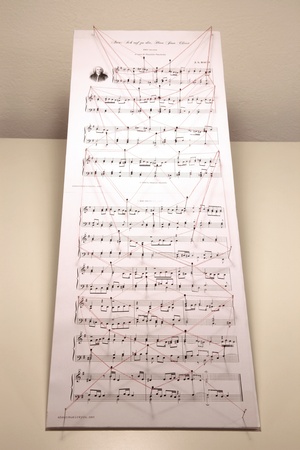
Zuzana Žabková, Ich ruf zu dir, 2012 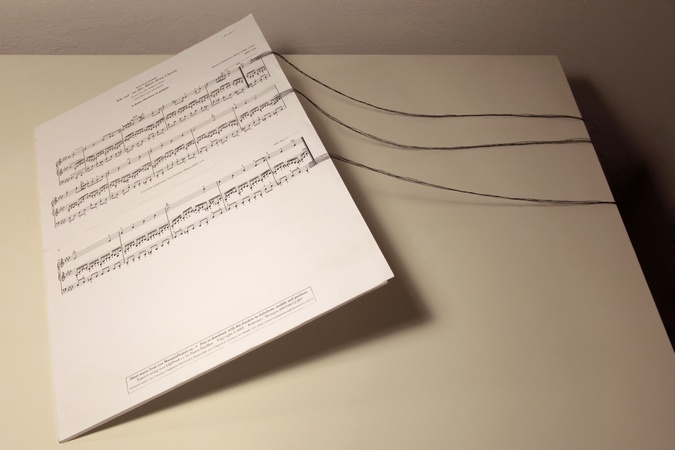
Zuzana Žabková, Ich ruf zu dir, 2012 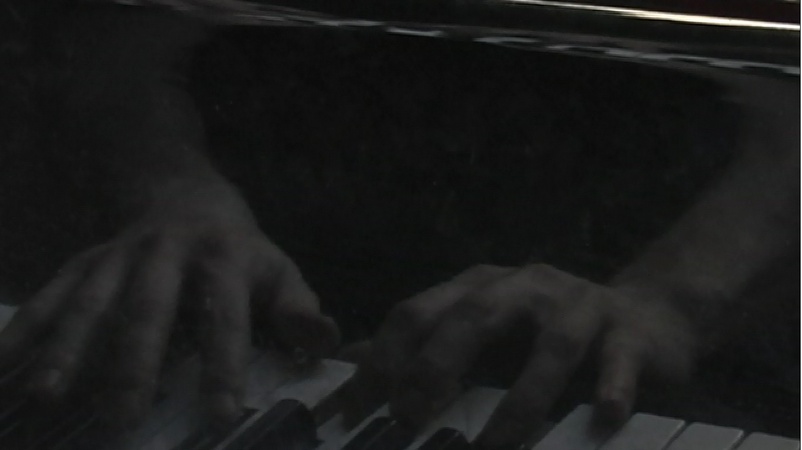
Zuzana Žabková, Small odyssey II. /Careful adventures, single video, 00:02:37 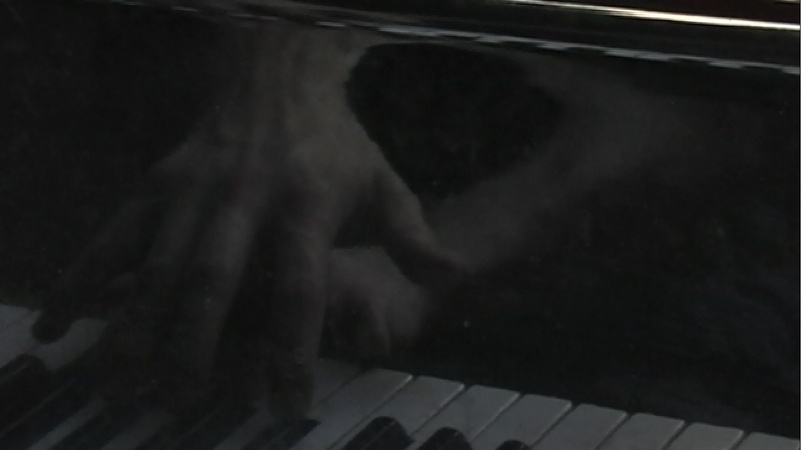
Zuzana Žabková, Small odyssey II. /Careful adventures, single video, 00:02:37 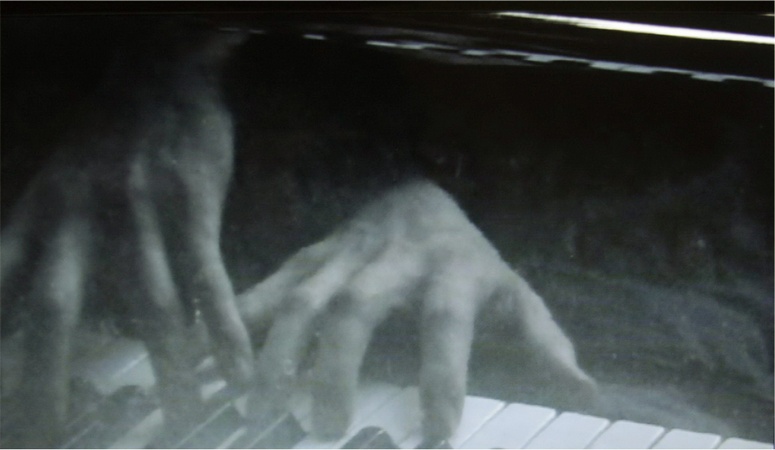
Zuzana Žabková, Small odyssey II. /Careful adventures, single video, 00:02:37 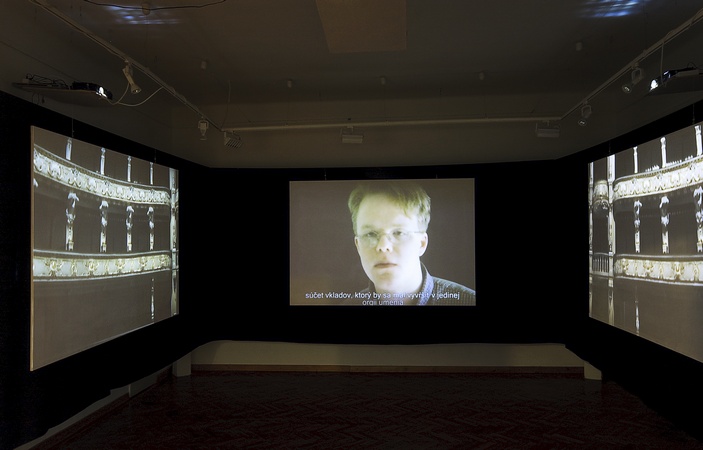
András Cséfalvay, Maquette, Maquette/Maketa, 2009, video, 00:26:00 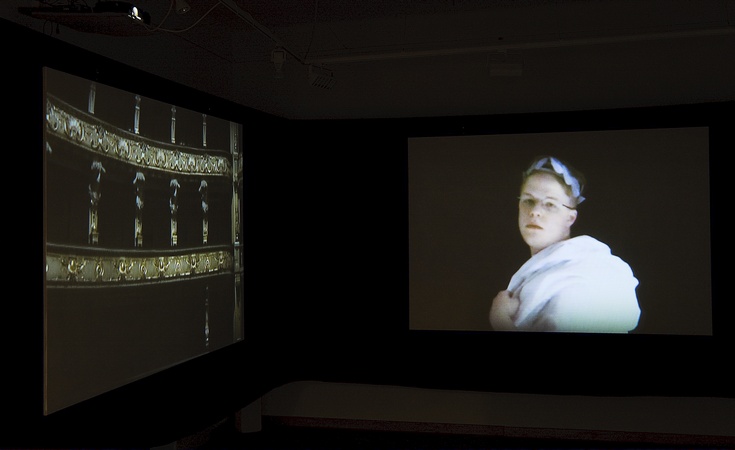
András Cséfalvay, Maquette, Maquette/Maketa, 2009, video, 00:26:00 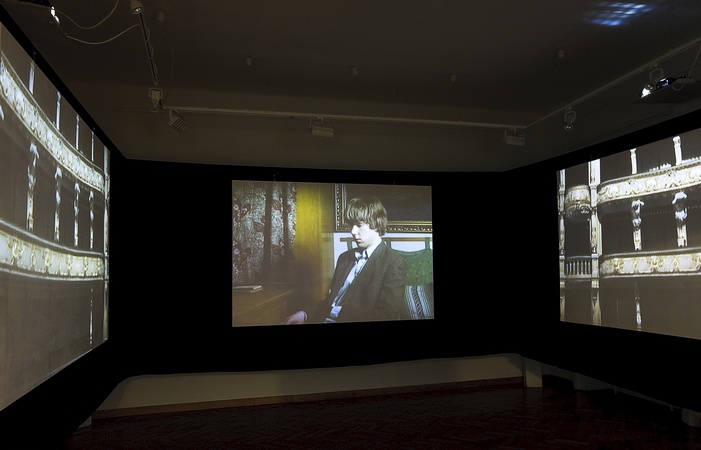
András Cséfalvay, Maquette, Maquette/Maketa, 2009, video, 00:26:00
The On The Stage exhibition will present three Slovak artists focusing on the relationship between perception of an artwork, the spectator and the stage, representation and the related difficulties.
The main topic of works by András Cséfalvay include presentation of human ambitions, tendency towards saving the mankind, messianism, fallen heroes, inability to fulfil ambitions, and the emptiness of heroic deeds. These topics often appear in classical operas. András Cséfalvay will exhibit Maquette/Maketa – the work for which he received the 2009 Oskár Čepan Award, and one which is even today still among his most distinct works. This artist often utilises music in his works, even having recently released his own music album. The main protagonist of this work – a maquette of an opera – is András Cséfalvay himself, with the pivotal topic being his ambition to create a monumental epic opera, with a symphonic orchestra, epic stage design and everything else that it takes. Maquette/Maketa is a model of an opera, consisting of three video-projections evoking an opera scene. On the sides of a dark drapery, he projects static images of empty theatre loges, while the core of the projection – a sketch of an opera opus – takes place in the centre. The video, in which the author fully takes on the role of the main author, composer, director, musician, singer and actor, tells about several unfinished operas, with the individual parts being illustrated by the proposed musical and visual motives. The key storyline of the cycle presents the main protagonist in the centre of attention. In his story, we perceive his constant attempts to succeed and his consequent failures. András Cséfalvay is interested in opera mainly as in a Gesamkunstwerk – and creating it is supposed to prove his success, his achievement of a lifelong goal. The work is a maquette, and although it does work on its own as a standalone work of art, it also draws attention to the fact that an opera actually does not need to be ever finished.
Ilona Németh will present a monumental site-specific installation entitled Auditorium/Hľadisko, alluding to self-referencing, disturbing the roles of spectator and actor. A metal construction with plastic chairs resembling an open-air stadium. The interior construction akin to a scaffolding does not make up an independent statue, since it is always adjusted to the actual exhibition premises. This aggressive and at the same time fascinating construction, with its own rhythm and repetitive character, also suggests the motive of an echo, the impossibility of a dialogue, a stalemate situation. Among other things, the project also refers to the currently complicated power relations within the institutions of contemporary art in the Central-European domain. In a similar way as András Cséfalvay’s opera, Ilona Németh’s project is about balancing on the edge between success and failure.
The video entitled Small Odyssey II (2011) by Zuzana Žabková is an introvert contemplation about the means of expression, about emptiness, and in a similar way as the other works, also about the possible failure. The video captures a play on piano, but the music instrument is not producing any melody; all we hear is the gentle sound of fingers touching the keys. The video is a specific choreography for hands. Ich ruf zu dir (2011) is the incomplete title of a Johann Sebastian Bach cantata that Zuzana Žabková used as a starting point for the realization of five pieces of sheet music. The red boxes are part of another work by Zuzana Žabková, ForRrose (2013),that refers to Marcel Duchamp and his alter ego Rrose Sélavy. However, in the context of the exhibition, the difficulty of hearing is evoked through the use of cotton swabs. Young artist Zuzana Žabková is known for specifically combining contemporary choreography, dance, and visual arts. She focuses on video art, video-performance, choreography, installation, sound-art, and their derivatives. In her works, she often manipulates the definitions of “today’s usual utopias”. By means of an experiment, she gains overview of the variability of the given definitions, thus learning together with the audience from her own mistakes. Perhaps also for a better future.
La mostra On the Stage presenta tre artisti slovacchi che focalizzano il tema della relazione tra la percezione di un’opera d’arte, lo spettatore e la scena, nel senso di rappresentazione e relative difficoltà.
Il tema principale dei lavori di András Cséfalvay include la presentazione delle ambizioni umane, la tendenza a voler salvare l’umanità, il messianismo, la caduta degli eroi, l’incapacità di conseguire le ambizioni e il vuoto delle gesta eroiche. Tali tematiche spesso appaiono nelle opere classiche. András Cséfalvay propone in mostra Maquette/Maketa, lavoro per il quale ha ricevuto il Premio Oskár Čepan 2009 e che è uno tra i suoi lavori più significativi. L’artista spesso utilizza la musica nei suoi lavori e ha recentemente pubblicato il suo primo album musicale. Il protagonista principale dell’opera in mostra è lo stesso András Cséfalvay alle prese con l’ambizione di creare un’opera epica monumentale, con un’orchestra sinfonica, una scenografia epica e tutto il resto di cui vi può essere bisogno. Maquette/Maketa è un modello di un’opera consistente in tre videoproiezioni che evocano la scena di un’opera. Sui lati di un drappeggio scuro, l’artista proietta immagini statiche di palchi di teatro vuoti, mentre il nucleo della proiezione – una scena di un’opera – avviene al centro. Il video, in cui l’artista assume il ruolo di principale autore, compositore, regista, musicista, cantante e attore, racconta diverse opere incompiute, attraverso l’illustrazione dei moventi musicali e visuali proposti. La chiave di lettura del ciclo propone il protagonista principale al centro dell’attenzione. Nella sua storia, percepiamo i suoi costanti tentativi di avere successo e i suoi conseguenti fallimenti. András Cséfalvay è interessato all’opera come Gesamkunstwerk – e creandola suppone di dimostrare il suo successo, il raggiungimento dell’obiettivo di tutta una vita. Il lavoro è una maquette e anche se funziona da solo come autonoma opera d’arte, richiama l’attenzione sul fatto che l’opera in realtà non ha mai realmente bisogno di essere finita.
Ilona Németh presenterà un’installazione monumentale site-specific dal titolo Auditorium/Hľadisko che allude all’autoreferenzialità, sconvolgendo i ruoli di spettatore e attore. Una costruzione in metallo con sedie di plastica simili a uno stadio a cielo aperto. La struttura interna, simile ad un ponteggio, non costituisce una scultura indipendente ma si adegua di volta in volta agli spazi in cui viene esposta. Questa costruzione affascinante e allo stesso tempo aggressiva, con un proprio ritmo e una natura ripetitiva, suggerisce anche il motivo di un’eco, l’impossibilità di un dialogo, una situazione di stallo. Tra le altre cose, il progetto si riferisce anche agli attuali complicati rapporti di forza fra le istituzioni di arte contemporanea nell’area dell’Europa centrale. Analogamente all’opera di András Cséfalvay, il progetto di Ilona Németh attiene all’equilibrio precario tra successo e fallimento.
Il video dal titolo Small Odyssey II (2011) di Zuzana Žabková è una contemplazione introversa sui mezzi di espressione, sulla vacuità e, come per le altre opere in mostra, anche sul possibile fallimento. Il video mostra una persona che suona il pianoforte, ma lo strumento musicale non produce alcuna melodia; tutto ciò che sentiamo è il suono dolce delle dita che toccano i tasti. Il video è una coreografia specifica per le mani. Ich ruf zu dir (2011) è il titolo incompleto di una cantata di Johann Sebastian Bach che Zuzana Žabková ha utilizzato come punto di partenza per la realizzazione di cinque partiture grafiche. La difficoltà di ascoltare, simboleggiata dal ricorso a bastoncini per la pulizia delle orecchie collocati all’interno di preziose scatolette rosse, è infine il tema dell’opera For Rrose (2013), che fa riferimento a Marcel Duchamp e al suo alter ego Rrose Sélavy. La giovane artista è nota in particolare per la capacità di unire coreografia contemporanea, danza e arti visive. La sua opera si concentra sulla videoarte, le performances video, la coreografia, il montaggio, la sound-art e loro derivati. Nelle sue opere l’artista manipola le definizioni di “utopie quotidiane abituali”. Attraverso degli esperimenti, fornisce una panoramica sulla variabilità delle definizioni date, imparando così insieme al pubblico dai suoi propri errori. Forse anche per un futuro migliore.
share on